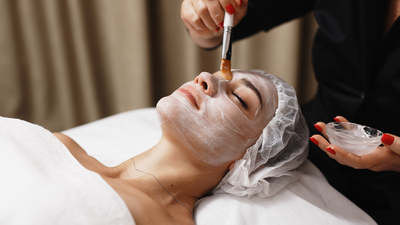To Peel or Not to Peel: Chemical Peels for the Skin
Chemical peels date back to ancient times. Their earliest uses were documented by ancient Egyptians, Greeks and Romans who combined various ingredients like salt and alabaster with oils and milk. Since then, new ingredients have advanced the technique and allowed for targeted and predictable exfoliation to specific depths or layers of the skin.
Based on this principle, formulas are divided into superficial, medium and deep chemical peels. The appropriate depth is determined not only by the condition treated but other factors like skin type and color. This controlled exfoliation is achieved by selecting the appropriate chemicals and concentrations.
Superficial Chemical Peels
 Superficial chemical peels help exfoliate the top layer of the skin known as the epidermis. These peels include alpha and beta hydroxy acids, Jessner’s solution, and others. They’re typically used to treat conditions of pigment deposition such as melasma or age spots known as lentigines. Studies of superficial peels have also demonstrated new collagen formation and an overall thicker smoother skin texture. These benefits can be easily maintained with a quality moisturizing and sun-protection regimen.
Superficial chemical peels help exfoliate the top layer of the skin known as the epidermis. These peels include alpha and beta hydroxy acids, Jessner’s solution, and others. They’re typically used to treat conditions of pigment deposition such as melasma or age spots known as lentigines. Studies of superficial peels have also demonstrated new collagen formation and an overall thicker smoother skin texture. These benefits can be easily maintained with a quality moisturizing and sun-protection regimen.
Medium Depth Chemical Peels
Medium depth chemical peels exfoliate the entire epidermis and the upper portion of the underlying dermis. Common agents include trichloroacetic acid either alone or in combination with other ingredients like beta-hydroxy acids, Jessner’s solution or solid carbon dioxide. Medium depth peels are mainly used to erase wrinkles and age spots – both signs of aging and sun damage. Dermatologists use these peels either alone or in combination with other treatments to improve acne scarring and eliminate precancerous lesions known as actinic keratoses.
Deep Chemical Peels
Deep chemical peels are used for extensive sun damage including deep wrinkles that are visible not only when you smile but also at rest. The most commonly used deep chemical peel, the Gordon-Baker peel, dates back to the 1960s. Despite its safety profile, the Gordon-Baker peel is often performed after administration of local anesthetic and requires one to two weeks of downtime. Its benefit, though dramatic, is often best appreciated in the 1-2 months following the procedure.
What Do Facial Peels Treat?
Melasma
Melasma is a condition in which pigment inappropriately builds up in the skin. The exact cause is unknown, but the condition is made worse with sun exposure. In skin of color, some superficial chemical peels have been shown to effectively reduce melanin, the main pigment molecule produced in the skin.
Photoaging and Actinic Keratoses
Chronic sun exposure leads to alterations in skin pigment, wrinkles, roughness, skin thinning and precancers known as actinic keratoses. Chemical peels can help to thicken the epidermis, redistribute pigment and induce new collagen growth. Though superficial peels can be used in early photoaging, medium-depth and deep chemical peels are more effective when photoaging is moderate to severe. In patients with sun-related precancers, studies have shown an 80% reduction in actinic keratoses three months after a treatment.
Acne
In mild to moderate acne, chemical peels are useful supplements to topical and systemic medications. Chemical peels can improve skin texture, reduce pore size, reduce oil secretion and improve the skin’s overall appearance. Not only do chemical peels improve comedonal acne (blackheads & white heads), they also improve inflammatory acne. Chemical peels also help clear acne related pigmentation and scarring and allow for better penetration of topical creams prescribed by your dermatologist.
Special Considerations for Chemical Peels
Skin of color
Though chemical peels are safe in skin of color, consideration of skin type (including color and texture) should be made to avoid uncontrolled pigment changes. In those with tan to brown skin tones, selecting the appropriate chemicals and beginning with a skin preconditioning regimen prescribed by your dermatologist can help prevent unexpected complications like skin darkening and enhance the benefits of chemical peels.
Pregnancy
Though some chemical peels should not be used in women who are planning or attempting to become pregnant, many superficial peels are perfectly safe in pregnancy. These include superficial chemical peels with naturally occurring acids found in milk, almonds, sugar cane, citrus fruits and apples.
In addition to the conditions above, other medical uses for chemical peels include milia, enlarged oil glands, age spots, warts, rosacea, razor bumps and freckles.
BOTTOM LINE: Chemical peels are quick, non-invasive office procedures performed in the clinic by a trained professional. Many types of peels require minimal downtime and recovery. Chemical peels can be used to treat a variety of dermatologic conditions from acne to melasma to precancers. They can also be used to improve skin signs of aging by improving the skin’s color and texture.

